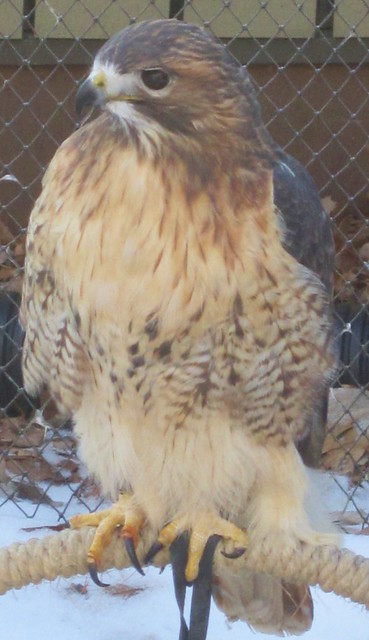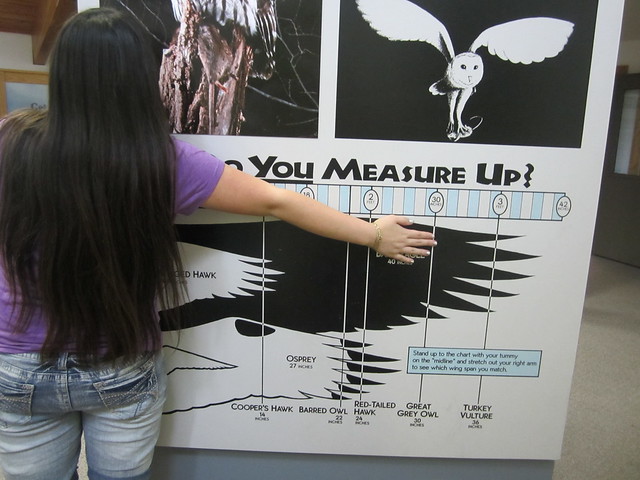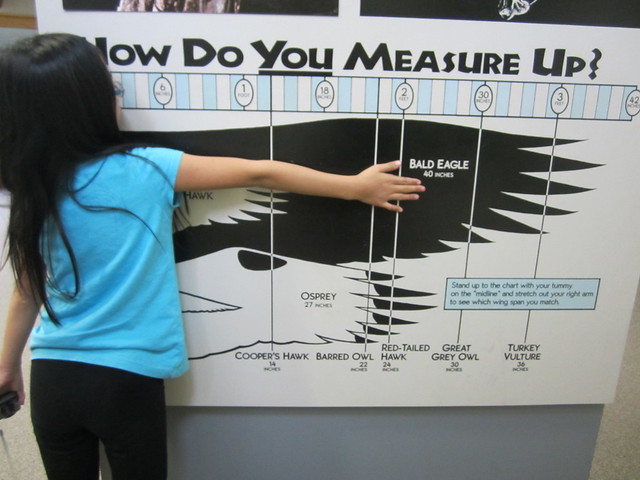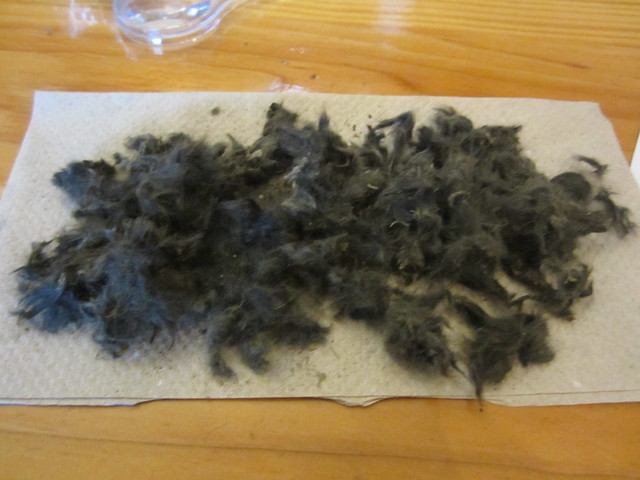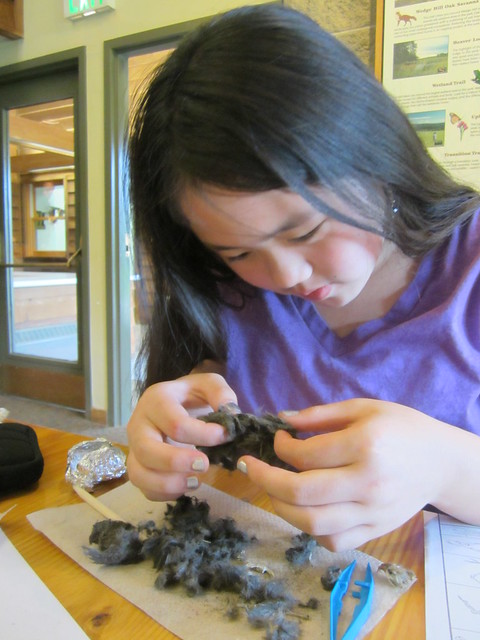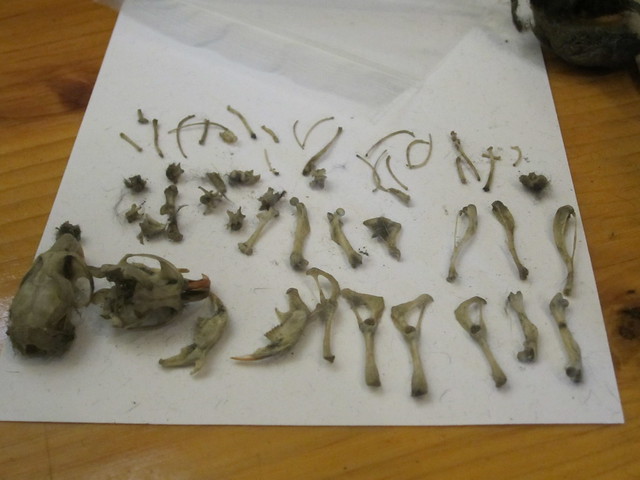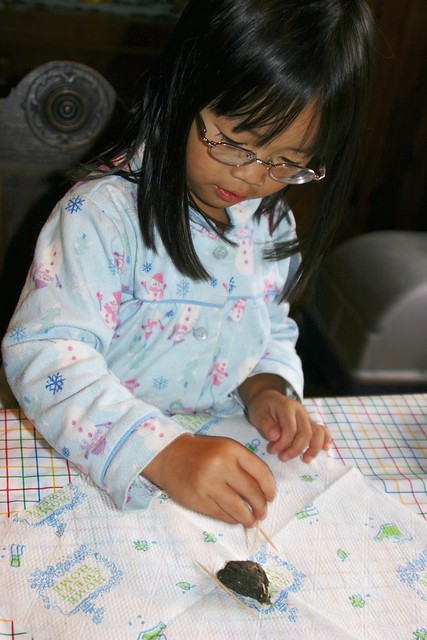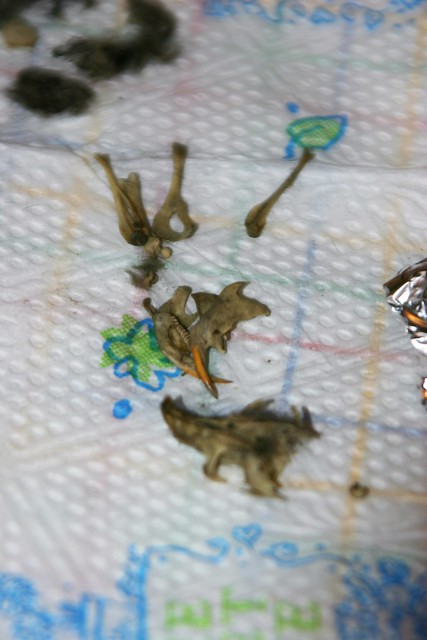For this week's Outdoor Hour Challenge, we focused on hawks. Here in Minnesota, there are many nine types of hawks that can be seen: broad-winged, cooper's, ferruginous, northern goshawk, red-shouldered, red-tailed, rough-legged, sharp-shinned, and swainson's.
This hawk was very close to the wetland observation deck
at the Minnesota Valley National Wildlife Refuge.
The girls and I watched it on March 16, 2009,
as it kept scanning the ground for a meal.
It didn't seem to bother the hawk that we were there.
The person in the visitor center said it was either a
Cooper's Hawk or Sharp-shinned Hawk.
Collectively, all of the hawks can not be seen in all parts of the state, though. Some have certain areas they prefer (e.g., along the western border of the state) while others are prevalent throughout the state. Nonetheless, there is quite a variety of hawks in Minnesota - far more than we knew.
Their first Raptor Corps meeting was held on October 14, 2014. At the first meeting of the program in October, there was a presentation about the center itself and how its purpose.
Sophia and Olivia were listening to a presentation about raptors.
After that, the youth and parents were introduced to three different raptors - including a red-tailed hawk.
This is the foot with talons from a red-tailed hawk.
Each of the raptors received meat to eat. It was interesting to see the difference in eating habits between the birds.
The hawk is eating its dinner for the evening.
There are additional sessions beginning again in January (there was a break in December) and running until May. By the end of the school year the girls should both have a much deeper understanding and appreciation of raptors.
For this entry, I'm focusing on the most common hawk we see around our area: red-tailed hawk. It is also the most common hawk in North America. In addition to being in rural areas where they can be seen soaring over the open fields, hawks often can be seen perching on tall light posts along the highways with their eyes fixed on the ground to see the movements of a rabbit or vole.
All About Birds had some great information about hawks that is good to know.
Size and Shape
Red-tailed Hawks are large hawks that are very broad with rounded wings and a short, wide tail. Large females seen from a distance might fool you into thinking you’re seeing an eagle. (Until an actual eagle comes along.)
This hawk was at a nature center.
Due to injuries it had in the wild, it cannot be released
for its own safety and well-being.
We saw this hawk on Olivia's 10th birthday -
on January 18, 2013.
Color Pattern
Most red-tailed hawks are rich brown above and pale below, with a streaked belly and, on the wing underside, a dark bar between its shoulder and wrist. The tail is usually pale below and cinnamon-red above, though in young birds it’s brown and banded. “Dark-morph” birds are all chocolate-brown with a warm red tail. “Rufous-morph” birds are reddish-brown on the chest with a dark belly.
This gentleman had a hawk he trained like a falcon.
He was at a restaurant where were eating at with friends,
and we had the opportunity to touch its feathers.
The hawk was so soft and calm.
(This was on September 13, 2012.)
Behavior
Red-tailed hawks tend to soar in wide circles high over a field. When flapping, their wingbeats are heavy. In high winds they may face into the wind and hover without flapping with their eyes fixed on the ground. They attack in a slow, controlled dive with legs outstretched – much different from a falcon’s stoop.
We were at the Science Museum of Minnesota on October 12, 2007, and
saw this display about the wingspan of different raptors.
The largest is the California Condor, then the American Eagle,
Turkey Vulture, Osprey, Redtailed Hawk, and
one more (can't remember that one).
Olivia's armspan was about 3' total (1 1/2' on each side).
Sophia's was as big as a red-tailed hawk...or about 4' total
(slightly less than 2' on each side).
The girls were 6 1/2 and 4 1/2 years old at the time.
The red-tailed hawk is a bird of open country. It is most commonly seen along fields and perched on telephones poles, fence posts, or trees standing alone or along edges of fields. It can be seen in grasslands, roadsides, the desert, broken woodland, scrublands, fields and pastures, parks, and (in Mexico) tropical rainforest.
Food
Mammals make up the bulk of what most red-tailed hawks eat. Frequent victims include mice, voles, rabbits, wood rats, snowshoe hares, jackrabbits, and ground squirrels. The hawks also eat birds, including starlings, blackbirds, pheasants, and bobwhite as well as snakes and carrion. Individual prey items can weigh anywhere from less than an ounce to more than 5 pounds.
Nest Description
Both males and females build the nest or refurbish one of the nests that they have used in previous years. Nests are tall piles of dry sticks up to 6.5 feet high and 3 feet across. The inner cup is lined with fresh foliage, bark strips, and dry vegetation. Construction of the nest takes 4-7 days.
Nest Placement
Red-tailed hawks prefer to place their nests in the crowns of tall trees where they have a commanding view of the landscape. They may also nest on a cliff ledge or on artificial structures such as window ledges and billboard platforms.
Nesting
The clutch size is 1-5 white or buffy, blotched, or speckled with buff, brown, or purple eggs. There is one brood per year. The eggs incubate for 28-45 days and the nestling period is 42-46 days.
Sound
Adults make a hoarse, screaming kee-eeeee-arr. It lasts 2-3 seconds and is usually given while soaring. We listened to more sounds that both adults and young hawks make. When we played the sounds (especially the adult ones), the dogs immediately looked up from resting. This is a sound all-too common and one that can indicate trouble for small mammals and birds.
Interesting Fact
The Red-tailed hawk is one of the largest birds that is in North America, yet even the biggest females weigh only about three pounds. A similar-sized small dog might weigh ten times that.
Nature Journal Entries
Each of the girls focused on a different hawk. Olivia chose the ferruginous and Sophia chose the red-tailed hawk.
This is Sophia's journal entry:
This is Olivia's journal entry:
We used Backyard Birds - Hawks and Their Calls as inspiration.





